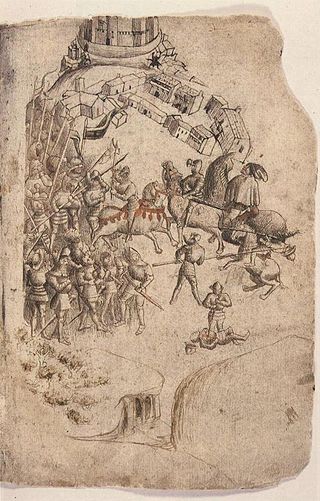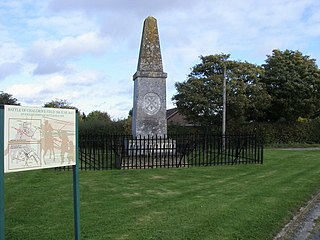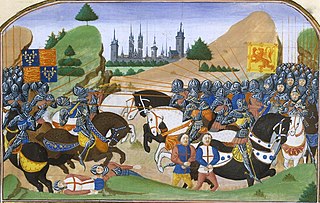Related Research Articles

The Battle of Stirling Bridge was fought during the First War of Scottish Independence. On 11 September 1297, the forces of Andrew Moray and William Wallace defeated the combined English forces of John de Warenne, 6th Earl of Surrey, and Hugh de Cressingham near Stirling, on the River Forth.

The Battle of Bannockburn was fought on 23–24 June 1314, between the army of Robert the Bruce, King of Scots, and the army of King Edward II of England, during the First War of Scottish Independence. It was a decisive victory for Robert Bruce and formed a major turning point in the war, which ended 14 years later with the de jure restoration of Scottish independence under the Treaty of Edinburgh–Northampton. For this reason, the Battle of Bannockburn is widely considered a landmark moment in Scottish history.

The Royal Scots Greys was a cavalry regiment of the Army of Scotland that became a regiment of the British Army in 1707 upon the Union of Scotland and England, continuing until 1971 when they amalgamated with the 3rd Carabiniers to form the Royal Scots Dragoon Guards.

The Battle of Falkirk, on 22 July 1298, was one of the major battles in the First War of Scottish Independence. Led by King Edward I of England, the English army defeated the Scots, led by William Wallace. Shortly after the battle Wallace resigned as Guardian of Scotland.

The Battle of Solway Moss took place on Solway Moss near the River Esk on the English side of the Anglo-Scottish border in November 1542 between English and Scottish forces.

Border reivers were raiders along the Anglo-Scottish border. They included both Scottish and English people, and they raided the entire border country without regard to their victims' nationality. They operated in a culture of legalised raiding and feuding. Their heyday was in the last hundred years of their existence, during the time of the House of Stuart in the Kingdom of Scotland and the House of Tudor in the Kingdom of England.

The Battle of Dunbar was fought between the English New Model Army, under Oliver Cromwell, and a Scottish army commanded by David Leslie on 3 September 1650 near Dunbar, Scotland. The battle resulted in a decisive victory for the English. It was the first major battle of the 1650 invasion of Scotland, which was triggered by Scotland's acceptance of Charles II as king of Britain after the beheading of his father, Charles I on 30 January 1649.

The Anglo-Scottish war (1650–1652), also known as the Third Civil War, was the final conflict in the Wars of the Three Kingdoms, a series of armed conflicts and political machinations between shifting alliances of religious and political factions in England, Scotland and Ireland.

Archibald Douglas, 6th Earl of Angus was a Scottish nobleman active during the reigns of James V and Mary, Queen of Scots. He was the son of George, Master of Angus, who was killed at the Battle of Flodden, and succeeded as Earl of Angus on the death of his grandfather, Archibald.

Between 1639 and 1652, Scotland was involved in the Wars of the Three Kingdoms, a series of conflicts which included the Bishops' Wars, the Irish Rebellion of 1641, the English Civil War, the Irish Confederate Wars and finally the conquest of Ireland and the subjugation of Scotland by the English New Model Army.
Sir Thomas Wharton, 1st Baron Wharton was an English nobleman and a follower of King Henry VIII of England. He is best known for his victory at Solway Moss on 24 November 1542 for which he was given a barony.

The Battle of Scarrifholis, also spelt Scariffhollis was fought on 21 June 1650, near Letterkenny in County Donegal during the Cromwellian conquest of Ireland. A force loyal to the Commonwealth of England under Charles Coote defeated the Catholic Ulster Army, commanded by Heber MacMahon, Roman Catholic Bishop of Clogher.

The Battle of Inverkeithing was fought on 20 July 1651 between an English army under John Lambert and a Scottish army led by James Holborne as part of an English invasion of Scotland. The battle was fought near the isthmus of the Ferry Peninsula, to the south of Inverkeithing, after which it is named.
The Battle of Ancrum Moor was fought during the War of the Rough Wooing in 1545. The Scottish victory put a temporary end to English incursions in the Scottish border and lowlands. The battlefield has been included in the Inventory of Historic Battlefields in Scotland and protected by Historic Scotland under the Historic Environment (Amendment) Act 2011.

The Battle of Chalgrove Field took place on 18 June 1643, during the First English Civil War, near Chalgrove, Oxfordshire. It is now best remembered for the death of John Hampden, who was wounded in the shoulder during the battle and died six days later.

Historically, Scotland has a long military tradition that predates the Act of Union with England in 1707. Its soldiers today form part of the armed forces of the United Kingdom, more usually referred to domestically within the UK as the British Armed Forces.

Horses were widely used during the Napoleonic Wars for combat, patrol and reconnaissance, and for logistical support. Vast numbers were used throughout the wars. During the War of the Sixth Coalition, depletion of the French cavalry arm through attrition and loss of horse-producing allies to provide remounts contributed significantly to the gradual French defeat and downfall of the French Empire. During the Waterloo Campaign, the Armée du Nord had 47,000 horses: 25,000 cavalry, 12,000 for artillery, 10,000 for infantry and supply columns.

The Battle of Sark, or the Battle of Lochmaben Stone, was fought between Scotland and England on 23 October 1448 or 1449. It was a decisive Scottish victory, the first since the Battle of Otterburn in 1388, and the last pitched battle to be fought between the two kingdoms during the Medieval period.

The Weardale campaign, part of the First War of Scottish Independence, occurred during July and August 1327 in Weardale, England. A Scottish force under James, Lord of Douglas, and the earls of Moray and Mar faced an English army commanded by Roger, Lord Mortimer of Wigmore, accompanied by the newly crowned Edward III.
The Capture of Wadi el Hesi and the associated Sausage Ridge, began during the evening of 7 November 1917, was fiercely fought for during 8 November and not cleared until the early hours of 9 November, at the beginning of the pursuit phase of the Southern Palestine Offensive in the Sinai and Palestine Campaign during World War I. The advancing British Empire units of the Egyptian Expeditionary Force (EEF) were held by rearguard units of the withdrawing Ottoman Empire units of the Yildirim Army Group, holding a strategically strong position to the north of Gaza.
References
- ↑ Archibald, Malcolm (18 July 2021). Dance If Ye Can: A Dictionary of Scottish Battles. Next Chapter. pp. 112–113. ISBN 978-4-86751-339-2.
- ↑ King, Andy; Etty, Claire (5 October 2015). England and Scotland, 1286-1603. Bloomsbury Publishing. p. 138. ISBN 978-1-350-30697-4.
- ↑ Phillips, Gervase (1999). The Anglo-Scots Wars, 1513-1550: A Military History. Boydell Press. pp. 214–216. ISBN 978-0-85115-746-7.
- ↑ Fraser, George MacDonald (28 June 2012). The Steel Bonnets. HarperCollins Publishers. pp. 265–266. ISBN 978-0-00-747428-8.
Secondary Sources
- Markham, John Thorpe (1858). "The Scottish series, of the reigns of Henry VIII, Edward VI, Mary, Elizabeth, 1509-1589 pg. 80".
- The Good Lord Wharton: His Family, Life, and Bible Charity. Congregational Union of England and Wales. 1906.